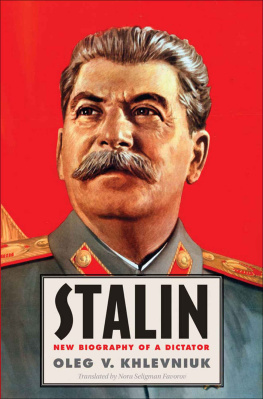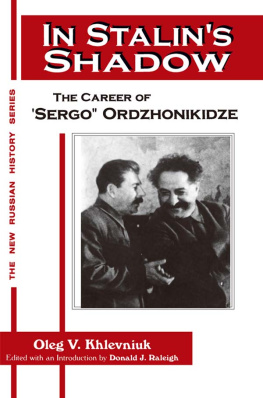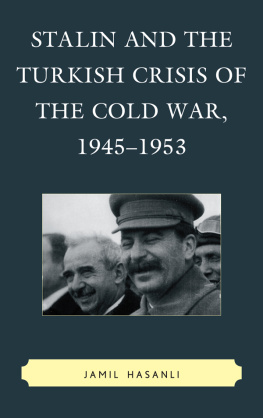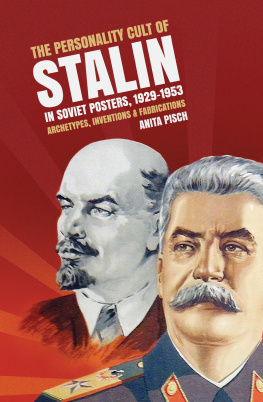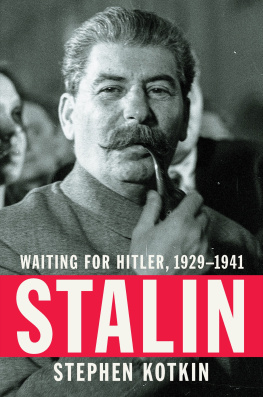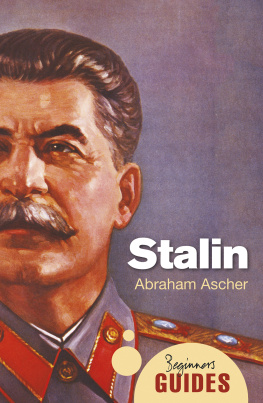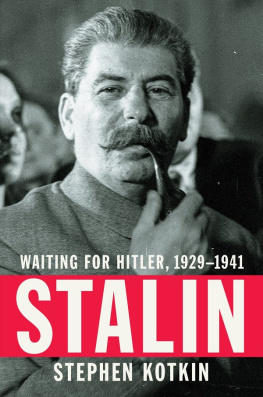STALIN
STALIN
NEW BIOGRAPHY OF A DICTATOR
Oleg V. Khlevniuk
Translated by NORA SELIGMAN FAVOROV

Yale University Press gratefully acknowledges the financial support given for this publication by the Smith Richardson Foundation.
Published with assistance from the foundation established in memory of Calvin Chapin of the Class of 1788, Yale College.
Copyright 2015 by Oleg Khlevniuk.
English translation copyright 2015 by Yale University.
All rights reserved.
This book may not be reproduced, in whole or in part, including illustrations, in any form (beyond that copying permitted by Sections 107 and 108 of the U.S. Copyright Law and except by reviewers for the public press), without written permission from the publishers.
Yale University Press books may be purchased in quantity for educational, business, or promotional use. For information, please e-mail (U.K. office).
Set in Utopia, Bodega, and Aller type by Integrated Publishing Solutions, Grand Rapids, Michigan.
Printed in the United States of America.
ISBN: 978-0-300-16388-9 (cloth)
Catalogue records for this book are available from the Library of Congress and the British Library.
This paper meets the requirements of ANSI/NISO Z39.481992 (Permanence of Paper).
10 9 8 7 6 5 4 3 2 1
In memory of my wife Katya (19612013)
CONTENTS
PREFACE
For more than two decades, I have been studying this man and the causes and logic underlying his actions, which upended or utterly destroyed millions upon millions of lives. This work has been stressful and emotionally draining, but it is my vocation. Lately, the paradoxical turns of recent Russian history, the large-scale poisoning of minds with myths of an alternative Stalinone whose effective stewardship is held up as a model worthy of emulationhave given my research more than scholarly relevance.
The literature on Stalin and his era is impossibly vast. Even scholars of Stalinism freely admit to not having seen the half of it. Within this vastness, serious, meticulously documented research coexists with slapdash pen-pushing carelessly cobbled together out of anecdotes, rumors, and fabrications. The two campshistorical scholarship and lowbrow (usually pro-Stalin) ramblingsrarely cross paths and have long since given up the idea of reconciling.
Scholarly biographies of Stalin have gone through the same stages as the historiography of the Soviet period overall. I have a high regard for some classics written at a time when Soviet archives were completely inaccessible. Two authors who stand out are Adam Ulam and Robert Tucker.
The opening of the archives gave rise to a new genre of Stalin biography that one might call the archival expos. Its trailblazers include Dmitri Volkogonov, a former party loyalist who became a driving force for perestroika, and the Russian playwright Edvard Radzinsky. This genre favors personal accounts over dry statistics or administrative paper trails and page-turning narratives over painstaking research and historical contextualization. For many readers, the archival expos has played an important role in shaping Stalins image.
One of the most successful Western authors working to feed appetites for newly available details about the Stalin era is Simon Sebag Montefiore. A notable feature of his method is the citation of a broad spectrum of sources, not only from memoirs and interviews, but also from the archives. Montefiore struck a sort of middle ground, striving to instill some scholarly discipline into the archival exposs genre while producing readable history capable of attracting a wider audience than more scholarly texts.
In todays Russia, on the other hand, Stalins image is primarily being shaped by pseudo-scholarly apologias. An extremely diverse array of authors, all with their own motivations, contributes to Stalinist mythology. Most of these authors blend a lack of the most elementary knowledge with a willingness to make bold assertions. Their apologias typically cite fabricated sources or shamelessly misrepresent real ones. The impact of this powerful ideological assault on readers minds is intensified by the circumstances of Russian life, which include rampant corruption and outrageous social iniquities. When they reject the present, people are more likely to idealize the past.
Apologists for Stalin no longer try, as they once did, to deny the crimes of his regime. Instead they resort to more subtle rewritings of history. In their version of events, lower-level officials, such as secret police chiefs and the secretaries of regional party committees, supposedly hiding their actions from Stalin, instigated mass repression. The most cynical Stalinists take a different tack, claiming that the Terror was just and that the millions destroyed on Stalins orders really were enemies of the people.
Many Russian Stalinists find it convenient to draw on theories developed by various Western historians: that the Terror developed spontaneously, that Stalin was not deeply involved in it, and that he was a far more ordinary political leader than usually thought. It is certainly not my intention to accuse my Western colleagues of fomenting re-Stalinization. They bear no more responsibility for Russias contemporary political battles than Marx did for the Bolshevik revolution. Still, we should be aware that our words can have bizarre reverberations.
One variety of apologia widely cultivated in Russias intellectual and political soil is the relatively moderate idea of modernizing Stalinism. While this ideology formally acknowledges the Terrors countless victims and the high price paid for the great leap strategy, it sees Stalinism as an organic and unavoidable means of addressing the need to modernize and prepare for war. Within these postulates we can detect prejudices deeply rooted in the Russian social consciousness: that the interests of the state take absolute priority, that the individual is insignificant, that the flow of history is governed by higher-order laws. According to this paradigm, Stalin was the expression of an objective historical need. His methods were regrettable but necessary and effective. Furthermore, it is inevitable that the flywheel of history will become spattered with blood.
It would be wrong to deny that the long waves of Russian history helped shape the path toward Bolshevism and Stalinism. A strong state with authoritarian traditions, feeble private property and civil society institutions, and the colossal reach of a colonizing power that enabled, among other things, the creation of the Gulag Archipelago, all paved the way toward the Stalinist system. But elevating these factors to some sort of Russian destiny leads to the dead-end theory of inevitable Stalinism. Adherents of this theory have little interest in specific facts and prefer to recycle Stalinist interpretations of Soviet history, sometimes with a fresh twist, more often without. They adamantly dismiss questions about the price paid for transformations and military victories, alternative development paths, and the role of the dictator. They close their eyes to the fact that Stalin himself, when he brought matters to a state of crisis and ruin, was occasionally forced to soften his policies, thereby demonstrating that even within the framework of Stalinism there were multiple paths toward industrialization. They do not even try to explain how the executions of seven hundred thousand people in 19371938 alone, ordered by Stalin, served the goals of modernization. Overall, the theory of modernizing Stalinism makes no serious attempt to ascertain how effective the Stalinist system was or to evaluate Stalins own role in the development of the USSR from the 1920s to the early 1950s.

